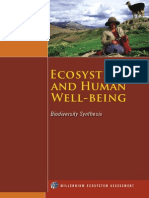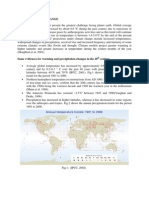Document
Document
Uploaded by
Lou BaldomarCopyright:
Available Formats
Document
Document
Uploaded by
Lou BaldomarOriginal Title
Copyright
Available Formats
Share this document
Did you find this document useful?
Is this content inappropriate?
Copyright:
Available Formats
Document
Document
Uploaded by
Lou BaldomarCopyright:
Available Formats
A.
Abiotic Factors (Climatic Factors)
1. **Macro Climate:** The macro climate refers to the long-term, large-scale weather patterns and
conditions that prevail over a broad geographical area. It includes factors such as average temperature,
precipitation levels, and seasonal variations. The macro climate sets the overall environmental backdrop
for ecosystems and influences the types of species that can thrive in a particular region (Lutgens et al.,
2020).
2. **Weather:** Weather represents the short-term atmospheric conditions and fluctuations in
temperature, humidity, precipitation, wind, and cloud cover that occur on a daily or hourly basis.
Weather is highly variable and can have immediate impacts on ecosystems and species behavior
(Ahrens, 2018).
3. **Climate:** Climate is a long-term average of weather patterns over a specific region. It provides a
more stable and predictable environmental context for ecosystems. Climate encompasses factors such
as average temperature, precipitation, and the seasonal distribution of these conditions. These long-
term climate patterns influence the distribution of plant and animal species (Peel et al., 2007).
4. **Microclimate:** Microclimate refers to localized, small-scale variations in climate within a specific
area. It can be influenced by factors like terrain, vegetation, and human-made structures. Microclimates
can create unique ecological niches, allowing certain species to thrive in areas where the overall
macroclimate might not be suitable (Geiger, 1965).
B. The Climatic Elements
1. **Precipitation:** Precipitation includes all forms of water that fall from the atmosphere to the
Earth's surface, such as rain, snow, sleet, and hail. The amount and distribution of precipitation
profoundly affect the availability of water for plants, animals, and human activities. Regions with high
rainfall support lush vegetation, while arid regions face water scarcity challenges (Trenberth, 2018).
2. **Temperature:** Temperature is a fundamental climatic element that influences the metabolic
processes, growth, and distribution of organisms. Extremes in temperature can limit the range of
species, and temperature fluctuations can affect breeding and hibernation patterns. Rising global
temperatures due to climate change have significant implications for ecosystems (Root et al., 2003).
3. **Wind or air in horizontal motion:** Wind patterns determine the movement of air masses and the
distribution of temperature and moisture across the Earth's surface. Winds can disperse seeds,
pollinators, and even influence ocean currents, affecting marine ecosystems. Wind patterns play a role
in shaping regional climates (Holton et al., 2020).
4. **Solar radiation or light:** Solar radiation, or sunlight, is the primary source of energy for nearly all
life on Earth. It drives photosynthesis in plants, which forms the base of food chains and ecosystems.
The angle and intensity of sunlight vary with latitude, time of day, and season, influencing the
productivity and biodiversity of ecosystems (Hartmann, 2016).
5. **Relative humidity:** Relative humidity is a measure of the amount of water vapor in the air relative
to its maximum capacity at a given temperature. It affects evaporation rates, plant transpiration, and the
ability of organisms to regulate their body temperature. High humidity can exacerbate the effects of
heat stress, while low humidity can lead to water loss in plants (Garratt, 1994).
These climatic factors and elements are essential components of the environmental framework that
shapes ecosystems and their inhabitants. Understanding their dynamics and interactions is crucial for
predicting the impacts of climate change, managing natural resources, and conserving biodiversity.
You might also like
- Elements of Ecology Canadian 1st Edition Smith Solutions ManualDocument2 pagesElements of Ecology Canadian 1st Edition Smith Solutions Manuala550154529No ratings yet
- Millennium Ecosystem Assessment 2005Document100 pagesMillennium Ecosystem Assessment 2005nephila100% (3)
- Unit-I Basic Introduction Meteorology and Agro MeteorologyDocument10 pagesUnit-I Basic Introduction Meteorology and Agro MeteorologyMounika pylaNo ratings yet
- Global Climate ChangeDocument13 pagesGlobal Climate ChangeAbhinaya VijayakumarNo ratings yet
- Climate Change and Its Effects On BiodiversityDocument3 pagesClimate Change and Its Effects On Biodiversityhadih23965No ratings yet
- Biomes, Zonation and SuccessionDocument13 pagesBiomes, Zonation and SuccessionVick DinNo ratings yet
- Agro ClimatologyDocument125 pagesAgro Climatologyasnakeketema12No ratings yet
- Agricultural MeterologyDocument63 pagesAgricultural Meterologymohan100% (4)
- 11Document4 pages11rohitgupta842004No ratings yet
- 1019920100206Document10 pages1019920100206ssyapatrissyaNo ratings yet
- Lec 14Document7 pagesLec 14wokep20470No ratings yet
- N Comms 8537Document11 pagesN Comms 8537marceloNo ratings yet
- Unit 4 Notes ITA Anna UniversityDocument14 pagesUnit 4 Notes ITA Anna Universityamalprasadkv2No ratings yet
- Solution Manual For Elements of Ecology Canadian 1st Edition by Smith Robert Smith and Waters ISBN 0321512014 9780321512017Document7 pagesSolution Manual For Elements of Ecology Canadian 1st Edition by Smith Robert Smith and Waters ISBN 0321512014 9780321512017michaelhurstiitarmcdingw100% (35)
- Jet 003 Edward Climate ChangeDocument12 pagesJet 003 Edward Climate ChangeAlessandro CrimaldiNo ratings yet
- ClimatologyDocument140 pagesClimatologyasnakeketema12No ratings yet
- Unit WA Icng: 18 Climate Change: GlobalDocument15 pagesUnit WA Icng: 18 Climate Change: GlobalNamita SahooNo ratings yet
- ClimateDocument11 pagesClimateLoeren CaronanNo ratings yet
- Concept Note EnglishDocument4 pagesConcept Note EnglishSantanuNo ratings yet
- Engineer ChikontweDocument13 pagesEngineer Chikontwechikontwesamuel43No ratings yet
- EHS 701 - Climate Change and Society Lecture (First Semester 2023-2024 Session) Oct 2024Document68 pagesEHS 701 - Climate Change and Society Lecture (First Semester 2023-2024 Session) Oct 2024oodeyemi246099No ratings yet
- Mpacts of Climate Change On Agriculture and Natural Environment: The Need For Collective Global Action (Chapter-8)Document26 pagesMpacts of Climate Change On Agriculture and Natural Environment: The Need For Collective Global Action (Chapter-8)AsifNo ratings yet
- Metereology 1Document4 pagesMetereology 1Meriam L. DumalagNo ratings yet
- BIOL 350 Lecture 14 (Controls On Ecosystem Structure & Function)Document32 pagesBIOL 350 Lecture 14 (Controls On Ecosystem Structure & Function)xcheshireNo ratings yet
- ArticleDocument11 pagesArticlenawaltNo ratings yet
- 2nd Term E - Note, SS 1Document13 pages2nd Term E - Note, SS 1atinukeelizabeth35No ratings yet
- Metrology AssignmentDocument9 pagesMetrology Assignmentshalini shuklaNo ratings yet
- Climate All Thinking AnswerDocument4 pagesClimate All Thinking AnswerSuman BhowmickNo ratings yet
- Climatology Plays A Crucial Role in Human Society As It Is The Scientific Study of Climate and Its LongDocument6 pagesClimatology Plays A Crucial Role in Human Society As It Is The Scientific Study of Climate and Its LongSuman BhowmickNo ratings yet
- Explain The Scope of Climatology and Elucidate The Roll of ClimatologistDocument8 pagesExplain The Scope of Climatology and Elucidate The Roll of ClimatologistAmaya InduwaraniNo ratings yet
- Energy Engineering Chapter 7Document13 pagesEnergy Engineering Chapter 7Ajaya KarkiNo ratings yet
- Module 1 Intro To Climate ChangeDocument12 pagesModule 1 Intro To Climate Changeyvonne ramosNo ratings yet
- ULOfDocument3 pagesULOfpahkiatshayneNo ratings yet
- MetereologyDocument4 pagesMetereologyMeriam L. DumalagNo ratings yet
- Atmosphere, Climate and Weather: Atmospheric LayersDocument11 pagesAtmosphere, Climate and Weather: Atmospheric LayersUdayveerSinghNo ratings yet
- Identification Plant and The Growth'SDocument15 pagesIdentification Plant and The Growth'SRidwan An-nawawiNo ratings yet
- Lecture Notes On Climatology: Integrated Meteorological Training CourseDocument90 pagesLecture Notes On Climatology: Integrated Meteorological Training CourseDasSonam100% (1)
- Global Warming and Climate ChangeDocument10 pagesGlobal Warming and Climate ChangeShashi Kant SinghNo ratings yet
- 01 Introduction Climate SystemDocument34 pages01 Introduction Climate SystemzhangyuluNo ratings yet
- Nature and Scope of ClimatologyDocument2 pagesNature and Scope of ClimatologyNova Chrono100% (1)
- Untitled DocumentDocument2 pagesUntitled Documentlozanomarcelo197No ratings yet
- Lesson 3 Climate ChangeDocument8 pagesLesson 3 Climate ChangeGhie MoralesNo ratings yet
- Climatology - Types Amd SubdivisionsDocument3 pagesClimatology - Types Amd Subdivisionsnperson1011No ratings yet
- Fifth Dean - NRMH 2.4 TheoryDocument66 pagesFifth Dean - NRMH 2.4 Theory56. Mansi JagadNo ratings yet
- H-Agromet 111 AgromindDocument111 pagesH-Agromet 111 AgromindAkshata bandariNo ratings yet
- AdharDocument14 pagesAdharsahoosoumya670No ratings yet
- Interaction of Man and Natural Systems and Other Topics in Environmental GeologyDocument26 pagesInteraction of Man and Natural Systems and Other Topics in Environmental GeologydeshmukhgeolNo ratings yet
- Climate Change and Emerging Food Safety Issues - A ReviewDocument14 pagesClimate Change and Emerging Food Safety Issues - A ReviewKerian FerreiraNo ratings yet
- Climate ChangeDocument2 pagesClimate Changers7798741No ratings yet
- Rishav Final MeteoDocument15 pagesRishav Final Meteonayan74888No ratings yet
- Applied Climatology-1Document117 pagesApplied Climatology-1Daniel ShebiruNo ratings yet
- Cliamte Change & SustainabilityDocument29 pagesCliamte Change & SustainabilityPiyush SinghNo ratings yet
- GIS Remote SensingDocument11 pagesGIS Remote Sensingakhuzaifa724No ratings yet
- Climate Notes Glencoe 14 1 14 2Document3 pagesClimate Notes Glencoe 14 1 14 2api-264090670No ratings yet
- EIA PPT 1&2Document71 pagesEIA PPT 1&2Ibrahim SirajNo ratings yet
- Josh (Climate Change) LatestDocument22 pagesJosh (Climate Change) Latestconnorleah859No ratings yet
- Abiotics FactorsDocument17 pagesAbiotics FactorsLay SalesNo ratings yet
- Principles of Environmental Science and EngineeringDocument40 pagesPrinciples of Environmental Science and EngineeringZiad N. ShatnawiNo ratings yet
- A Seminar Paper On Climate Change and Its Effects On Aquatic EnvironmentDocument25 pagesA Seminar Paper On Climate Change and Its Effects On Aquatic EnvironmentIorhee saviourNo ratings yet
- DocumentDocument3 pagesDocumentLou BaldomarNo ratings yet
- BibliographyDocument6 pagesBibliographyLou BaldomarNo ratings yet
- DocumentDocument2 pagesDocumentLou BaldomarNo ratings yet
- Agri 112 Input 2 1Document4 pagesAgri 112 Input 2 1Lou BaldomarNo ratings yet
- WhatWorksBrief 12Document5 pagesWhatWorksBrief 12Lou BaldomarNo ratings yet
- Group 5 - St. MatthewDocument9 pagesGroup 5 - St. MatthewLou BaldomarNo ratings yet
- Impact of Smoking Habits in Academic Performance of Grade 12 Students in Taft High SchoolDocument17 pagesImpact of Smoking Habits in Academic Performance of Grade 12 Students in Taft High SchoolLou Baldomar100% (1)
- Eat Up: Vertical Farming in Sustainable CitiesDocument38 pagesEat Up: Vertical Farming in Sustainable Citieshgordonsmith100% (1)
- UPSC IFS Forestry SyllabusDocument4 pagesUPSC IFS Forestry SyllabusamitraNo ratings yet
- Edible Agro Forestry TemplatesDocument56 pagesEdible Agro Forestry TemplatesDarie TodorNo ratings yet
- Ecology Practice 4.1 and 4.2Document13 pagesEcology Practice 4.1 and 4.2camila hartmannNo ratings yet
- 1.2 Systems and Models - JagDocument26 pages1.2 Systems and Models - Jagmia lamNo ratings yet
- ISCC 202 Sustainability Requirements 3.1Document61 pagesISCC 202 Sustainability Requirements 3.1Andrey BelyaevNo ratings yet
- Geography Project-1 (Akshara)Document6 pagesGeography Project-1 (Akshara)preethamkalle07No ratings yet
- Energy Flow and Material Cycling Through The EcosystemDocument5 pagesEnergy Flow and Material Cycling Through The EcosystemJaffy BustamanteNo ratings yet
- An Introduction To EcosystemsDocument7 pagesAn Introduction To Ecosystemsapi-245089911No ratings yet
- 5th Biology SBA LABS - INSTRUCTIONSDocument5 pages5th Biology SBA LABS - INSTRUCTIONScarlalewis39No ratings yet
- ENVISCI Whole Module PDFDocument65 pagesENVISCI Whole Module PDFErica PunzalanNo ratings yet
- Ministry of Education: Integrated Science Teacher'S Guide Grade 9Document25 pagesMinistry of Education: Integrated Science Teacher'S Guide Grade 9Nurhaisa SaliNo ratings yet
- Impact Assessment Accompanying The Proposal (Part 4)Document114 pagesImpact Assessment Accompanying The Proposal (Part 4)malinoursonNo ratings yet
- Avtopat 10 VardarDocument120 pagesAvtopat 10 VardarOsman RecepNo ratings yet
- Biogeochemical Cycles PDFDocument10 pagesBiogeochemical Cycles PDFmanoj_rkl_07100% (1)
- Envici - Course OutlineDocument18 pagesEnvici - Course OutlineHaröld BuènvenidaNo ratings yet
- Environmental Ethics PDFDocument1 pageEnvironmental Ethics PDFWaleed Khan100% (1)
- NIBRA - GuideforproposalSubmission - NRCP 1 PDFDocument52 pagesNIBRA - GuideforproposalSubmission - NRCP 1 PDFDanilo CapulongNo ratings yet
- Studi Mangrove SimeulueDocument12 pagesStudi Mangrove SimeulueRakhmat Dirgantara SaragihNo ratings yet
- Environmental Science and Engineering Lecture NotesDocument74 pagesEnvironmental Science and Engineering Lecture NotesArifNo ratings yet
- Ecological Restoration Work PDFDocument35 pagesEcological Restoration Work PDFKritika ShankarNo ratings yet
- SCIENCE Biology Exam Review PackDocument13 pagesSCIENCE Biology Exam Review Packmtayyab zahidNo ratings yet
- 10th Biology Mcqs NotesDocument31 pages10th Biology Mcqs Notessupersaad987No ratings yet
- Lecture8!9!20397 EcosystemDocument49 pagesLecture8!9!20397 EcosystemMehul VermaNo ratings yet
- EVS Question Bank & Question Paper of PRIST UniversityDocument8 pagesEVS Question Bank & Question Paper of PRIST Universityashutosh_das_22No ratings yet
- Project Proposal TemplateDocument3 pagesProject Proposal TemplateNimrah KhanNo ratings yet
- Water Resources Planning and ManagementDocument24 pagesWater Resources Planning and ManagementRajveer SaeNo ratings yet
- Ecological SuccessionDocument4 pagesEcological SuccessionChristine ShellyNo ratings yet
- Multidisciplinary Nature of Environmental Studies (RICHA)Document56 pagesMultidisciplinary Nature of Environmental Studies (RICHA)swati thesiyaNo ratings yet
































































































